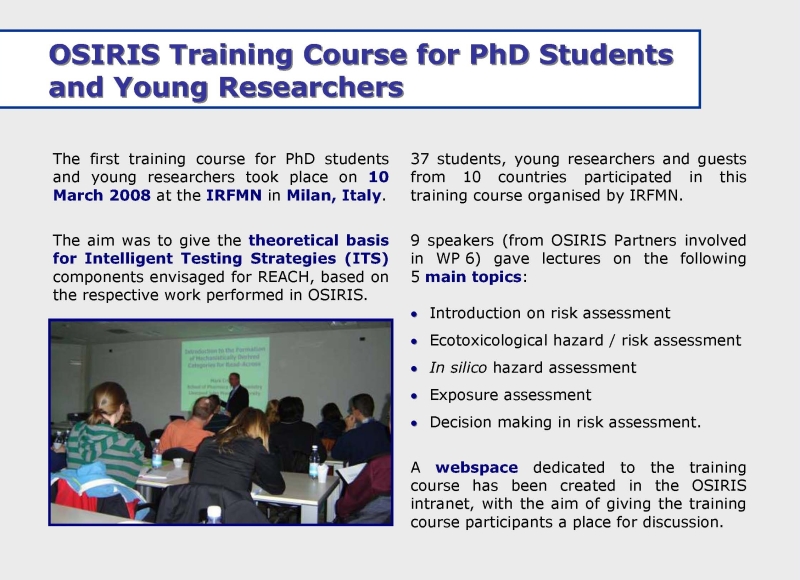First OSIRIS Training Course

Programme of the full day course on March 10 2008
| FROM | TO | SPEAKER | PRESENTATION | AREA |
|---|---|---|---|---|
| 09.30 | 10.15 | Dinant Kroese TNO | Toxicological risk assessment of chemicals in Europe, present and future. | INTRODUCTION ON RISK ASSESSMENT |
| 10.15 | 11.00 | Segner Helmut UB | Aquatic hazard assessment, present and future. | ECOTOXLOGICAL HAZARD / RISK ASSESSMENT |
| 11.00 | 11.20 | Coffee Break | ||
| 11.20 | 12.05 | Johan Robbens UA | Ecotoxicogenomics for Risk Assessment of chemical compounds: challenge and critical aspects. | |
| 12.05 | 12.50 | Robert Rallo & Francesc Giralt URV | Exploratory Analysis of REACH space using Self-Organizing Maps. ( | IN SILICO HAZARD ASSESSMENT |
| 12.50 | 14.15 | Lunch | ||
| 14.15 | 15.00 | Mark Cronin LJMU | Introduction to the Formation of Mechanistically-Derived Categories for Read-Across. | |
| 15.00 | 15.45 | Emilio Benfenati IRFMN | QSAR predictions for legislative purposes: challenge and critical aspects. ( | |
| 15.45 | 16.05 | Coffee Break | ||
| 16.05 | 16.50 | Stefan Trapp DTU | A short lesson on bioaccumulation of neutral and ionic organic compounds. ( | EXPOSURE ASSESSMENT |
| 16.50 | 17.35 | Theo Vermeire RIVM | Risk characterization: the start for decision making on chemical safety. ( | DECISION MAKING IN RISK ASSESSMENT |
Abstracts
-
Exploratory Analysis of REACH space using Self-Organizing Maps
Robert Rallo & Francesc Giralt
Universitat Rovira i Virgili (URV) - Tarragona, Catalunya
Chemicals can be characterized by a wide range of descriptors that could include topological, electronic or quantum features. In this context the chemical space is a synonym of a multidimensional set of descriptors, properties or activities of the chemicals considered. Families of compounds that are similar in terms of their physicochemical properties and molecular descriptors should cluster together within well-defined regions of the chemical space. Whether these clusters are evenly and sparsely distributed and therefore hard to find, or the chemical space is mostly empty with clusters of similar chemicals scattered far apart depends on the specific variables used to characterize the space and on the number of chemicals considered.
This lecture will focus on the application of the Self-Organizing Map (SOM), which is a non-linear and distance preserving projection method, to explore the multidimensional chemical space of REACH relevant compounds. The fundamentals of classification/clustering methods will be introduced first, followed by a description of the SOM algorithm and the basic guidelines for the interpretation of the maps. The application of the SOM for exploratory data analysis (variable relationship, feature selection, application domain, etc.) needed for proper QSAR modeling will be illustrated with some simple examples. 
 back to programme
back to programme-
Introduction to the Formation of Mechanistically-Derived Categories for Read-Across
Mark Cronin
School of Pharmacy and Chemistry, Liverpool John Moores University (LJMU) - Liverpool, UK
Within toxicological risk assessment, read-across is a method to fill data gaps where there are missing toxicity data. Part of the basis of read-across is the formation of “categories” or groups of chemicals that have similar properties. If a compound without toxicity data falls within a suitable category, then interpolation may be possible, thus eliminating the requirement for testing. The key to successful read-across is the formation of an appropriate category. There is a variety of approaches, the simplest is probably the analogue approach when the grouping is based on a very limited number of chemicals, with interpolation between these chemicals. There are, however, approaches to category formation based on our mechanistic understanding of toxic action. For instance, skin sensitisers can be identified on the basis of electrophilic mechanisms. To use this approach qualitatively requires the careful definition of the domain of each mechanism. To use category formation quantitatively, potency data are required and methods must be developed to achieve quantitative read-across. The local lymph node assay provides quantitative data for skin sensitisation and quantitative read-across will be illustrated using such data and descriptors for electrophilicity.

 back to programme
back to programme-
QSAR predictions for legislative purposes: challenge and critical aspects.
Emilio Benfenati
Istituto di ricerche farmacologiche Mario Negri (IRFMN) - Milano, Italia
In the USA and Canada a number of predictive models are in use, also for regulatory purposes, since a number of years. In Europe the REACH, the cosmetic legislation, and a series of initiatives, such as those promoted by the EPAA, have the effect to increase expectation and the discussion on the possible use of in silico methods for regulatory purposes, since there is a tendency to eliminate (for cosmetics) or reduce the use of animal models. However, a careful evaluation of the specific context of use of the in silico model has to be done, in order to employ in the correct way the methodology. Indeed, the in silico methods are very powerful and flexible tools, which can offer multiple outputs. The user has to evaluate the specific situation, and identify the constraints given by the context. The regulations are different in the different countries and for the different purposes. The different regulations may have different thresholds, and ask for a continuous value, for instance in case of risk assessment, or ask for a toxic category, for instance for classification and labelling. Even within the same regulation, such as REACH, different models should be more appropriate, depending on the tonnage. Indeed, more detailed information is required for higher tonnage. In some cases a classification can be sufficient (for classification and labelling for instance), in other cases a continuous value is necessary (for risk assessment, for instance). Thus, for the same endpoint, different in silico models may be preferable, depending on the situation.
Furthermore, it has to be noticed that models for regulatory purposes are not necessarily the most powerful. The intended use for regulatory purposes introduces restrictions, as we mentioned. For instance, a preference for public data results from the need to have a transparent model, which also refers to the access of the data of the training set. A model for regulatory purposes should be highly reproducible, independently from the country and user. These conditions conflict with other models, for industrial use, which can be based on confidential data and developed with methods which require manual optimisation done by an expert researcher. The results obtained in this way are highly valuable, but not optimal for regulatory purposes. 
 back to programme
back to programme-
A short lesson on bioaccumulation of neutral and ionic organic compounds
Stefan Trapp
Technical University of Denmark (DTU) - Kongens Lyngby, Denmark
The lecture starts with the definition of bioaccumulation of chemicals and gives an overview, why and where bioaccumulation is of importance in the rsik assessment process, from PBT assessment to indirect human exposure. Regressions to predict the bioaccumulation from the partition coefficient octanol water, Kow, were suggested in the Technical Guidance Document for risk assessment of chemicals (TGD) and in the REACH implementation process (RIP). Electrolytes or ionic compounds are compounds which can be charged, e.g., acids, bases and amphoteres. For ionic compounds, the method for BCF estimation is modified, using the Henderson-Hasselbalch equation. All methods are presented and explained.

 back to programme
back to programme-
Risk characterization: the start for decision making on chemical safety
Theo Vermeire
National Institute for Public Health and the Environment (RIVM) - Bilthoven, The Netherlands
This part of the course will address first of all the regulatory questions which have to be adressed in the risk characterization of industrial chemicals under REACH and the factors that play a role in decision making on chemicals. Next, it will be explained how the risk is characterized in the Chemical Safety Assessment for humans and for ecosystems based on the exposure scenario and the results of the exposure and effects assessment.
An important aspect of the risk characterization is uncertainty and variability in scenarios, models, and parameters and these will be explained. The student will hear how uncertainty and variability can be approached in the characterization of risks at various levels: point estimation, qualitative-refinement of this approach, range of point estimations and probablilistic approach. Examples will be given. And finally, some interpretation will be given on the meaning of the lesson learned for decision making and risk communication. 
 back to programme
back to programme